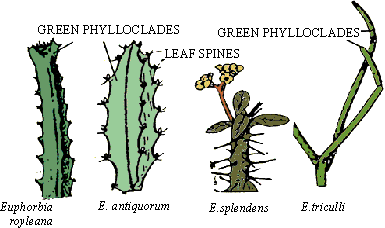|
PinkMonkey Online Study Guide-Biology
9.5 Plants as Sources of Hydrocarbons

Figure 9.3 Some latex-containing species of Euphorbis
(petro-plants)
(a) Introduction : There are certain species
of flowering plants belonging to different families which convert
a substantial amount of photosynthetic products into latex. The
latex of such plants contains liquid hydrocarbons of high molecular
weight (10,000da). These hydrocarbons can be converted into high
grade transportation fuel (i.e. petroleum). Therefore, hydrocarbon
producing plants are called petroleum plants or petroplants
and their crop as petrocrop. Natural gas is also one of the products
obtained from hydrocarbons. Thus, petroleum plants can be an alternative
source for obtaining petroleum to be used in diesel engines. Normally,
some of the latex-producing plants of families Euphorbiaceae, Apocynaceae,
Asclepiadaceae, Sapotaceae, Moraceae, Dipterocarpaceae, etc. are
petroplants. Similarly, sunflower (family Composiae), Hardwickia
pinnata (family Leguminosae) are also petroplants. Some
algae also produce hydrocarbons.
(b) Euphorbia : Different species of Euphorbia (Fig.
9.3) of family Euphorbiaceae serve as the petroplants. Dr. M. Calvin (1979)
was the first to collect the hydrocarbons from plants of Euphorbiaceae.
He suggested that these can be the renewable substitute for the conventional
petroleum sources. Latex of Euphorbia lathyrus contains
fairly high percentage of terpenoids. These can be converted into high
grade transportation fuel. Similarly the carbohydrates (hexoses) from
such plants can be used for ethanol formation.
(c) Sugarcane and sugar beet : Sugarcane (Saccharum
officinarum - family Gramineae) is the main source of raw material
for sugar industry. The wastes from sugar industry include bagasse, molasses
and press mud.
After extracting the cane juice for sugar production,
the cellulosic fibrous residue that remains is called bagasse.
It is used as the raw material (biomass) and processed variously for the
production of fuel, alcohols, single cell protein as well as in paper
mills.
Molasses is an important by-product of sugar mills and contains 50-55% fermentable sugars. One ton of molasses can produce about 280 liters of ethanol. Molasses is used for the production of animal feed, liquid fuel and alcoholic beverages.
Sugar beet (Beta vulgaris, family-Chenopodiaceae)
is yet another plant which contains a high percentage of sugars stored
in fleshy storage roots. It is also an important source for production
of sugar as well as ethanol.
Raising crops like sugarcane, sugar beet, tapioca, potato, maize etc. purely for production of ethanol is described as energy cropping, and the crops are called energy crops.
Cultivation of plants (trees) for obtaining fuel/fire wood is described as energy plantation.
|
SUMMARY : BIOENERGY
(1) Energy obtained from any biomass is called bioenergy. (2) Various kinds of organic wastes of plant or animal origin, residues from agricultural industries, municipal and domestic wastes, aquatic weeds, etc. provide the biomass. (3) Biogas (methane) is a very common source of bioenergy. (4) Domestic biogas is mostly produced from cattle dung and hence called gobar gas. (5) Producer gas also represents an alternative source of energy. (6) Plants of family Euphorbiaceae, Apocynaceae, Asclepiadaceae, etc. produced liquid hydrocarbons. These form the source for formation of liquid fuel (petroleum). Hence, hydrocarbon producing plants are called petroplants. (7) Bioenergy is a very good alternative for conventional fossil fuels. |
**********
|
Table of Contents
9.0 -
Introduction
9.1 Common Methods of Biogas Formation
9.2
Raw Materials and Substrates
9.3 Producer Gas
9.4 Methane
9.5 Plants as Sources of Hydrocarbons
Chapter 10
|